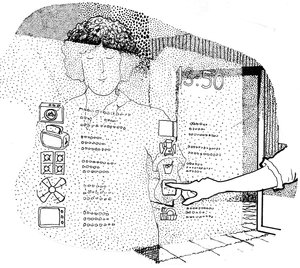Internet of Things – Part II – Business with IoT
What we will see in the coming years will be the emergence of important players in the world of IoT. We do not know whether the same – renewed – or others who will seize the opportunity. But just as PCs, then Smartphones and Tablets have entered everyone’s life, a sea of connected things will invade our lives and a phase of standardization, rules of use, security, market maturation will take place, and this has already begun.

We see an early development in IoT, which absorbs industry trends:
- Miniaturization
- Wireless Communication
- Connection commoditization
All these items are vital to IoT. The mobile devices have pulled quite a bit the development of batteries and antennas of reduced size. We remember the cell phones of the past, heavy and with more volume. In the case of these devices, an interface area has developed largely with the traditional features of display, audio, microphone, location, camera, etc.
Connected things, however, will not be able to give up these basic tendencies and opt for their way into this world.
To connect, using wireless communication, a thing or object needs to opt for some standard within the protocol ecosystem. There are the most widespread standards such as GSM, Wifi and Bluetooth, ZigBee, RFID, 802.15.4e and WPAN, RPL and others. This object needs to be discovered and possibly located through the request of these services, according to their function. It must then be identified and eventually configured. There, the connected object may or may not have power to maintain its data, but even without it, it will need to identify itself.
An important part is the sensors. Objects will always have to understand their surroundings, the variations, the signs, the important information to be able to communicate, either with another object or with a mobile (tablet or smartphone) as a mediation function. Thus, sensor technology is an important part of objects, of things connected.
With further sophistication, in addition to maintaining data storage, objects may have some intelligence correlating this information, reacting according to some historical ones. Of course, if you can still receive information from other objects, you will enrich yourself to “feel” the environment and provide more complex information.
In this sense, objects can even have some configuration of use, where you can configure some behavior in your interface.
In short, there will certainly be a wide range of formats, functions and intelligences, all of which are certainly seeking wireless communication, miniaturization, and cost reduction, all of which will benefit from scaling up and production.
Manufacturers of these objects will seek to reach out to customers – massive or corporate – in order to attract them to the benefits of everything. There is a myriad of applications, as we realize, in short, to sell these objects to a company, so you can say if it will benefit from increased business process efficiency and lower logistics costs. The costs of services will be reduced, enriching and partly automating the relationship with the end customer and thus, improving retention and increasing sales. Finally, new business models will still emerge and associated services that we still cannot imagine.
To imagine in a general framework how new models of Internet of Things would be, imagine a core where connected objects are managed by applications and a layer of analytical data enrich a collection of information collected, whether at home, in the car or in a company. There will be computational processes and services that can expose this new layer of knowledge when possible. Around the core, imagine a range of services that consume, combine, and re-distribute this information. Enterprise applications, ERPs, CRMs will benefit from this context. Social networks will also interact in a richer way. The business chain will be understood in a more extended way and the behavior that impacts business will be better measured. In addition, other objects will then consume this information again – which has been analyzed and converged from the core by the connected object sources.
That’s why we have the Smart jargon – previously applied to cities and electric power – Smart City and Smart Grid – while today we talk about Smart Health, Industry, Transport, Building, Living, Economy, etc. Much because IoT and M2M boost this vision of a new, much more connected world.
There is another important item in this context. It is the use of Software as a Service, and use of Cloud Computing in a general way. Today companies include in the treatment of their information, even in the information linked to their products, suppliers, partners and customers, sources from the cloud. Many companies already use enterprise applications in their own cloud, keeping systems in the home they think they need to keep. There are those who advocate a strong move from corporate IT systems to the cloud, some say that this will take place more conservatively. Anyway, in the case of IoT, much of the information is already born in the Cloud. Much of the processing of this information will be done there. We cannot imagine consumers or even companies developing at home or buying for your computer a series of applications that deal generally with connected objects and their data. However, in this ecosystem of partners and providers of these new services – born in the Cloud – should be more competitive and agile offering these features. So, even if you stay at home with your ERP and CRP, companies – for the sake of competition and survival – will integrate these classic solutions with information, services and applications in the Cloud. Thus, it is inevitable that IoT and M2M will be additional incentive themes for cloud computing.
The idea of the cloud as one-stop-shop for the corporate world may be an option. Startups, agile and modern companies will benefit from this new way to manage their information assets, and they will also be present in a connected world, therefore more agile and light. Looking at a near horizon, some industries will not take advantage of a first wave with this, due to their safety, regulatory and vision policy. But even these companies will need to integrate their home-based or legacy (on-premise) model with the cloud.
Main Image from pixabay.com from “Geralt”.